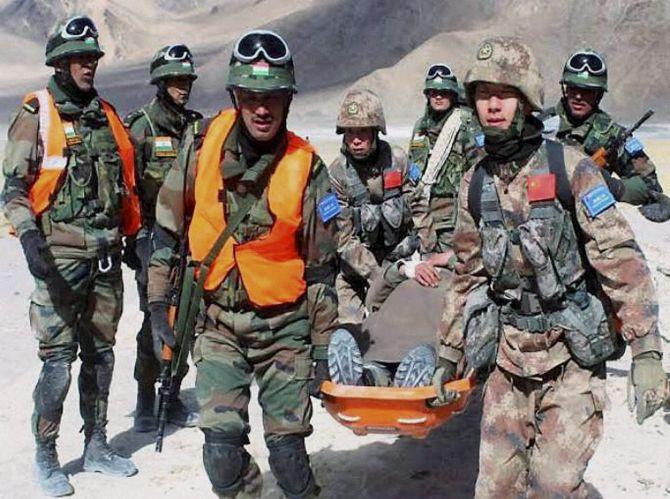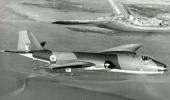'The potential of one such LAC engagement going out of control and leading to heavy casualties cannot be ruled out,' warns Lieutenant General Syed Ata Hasnain (retd).

Two clashes have occurred between Indian and Chinese soldiers in recent days, one each in North Sikkim and East Ladakh.
These are strange clashes by military standards as no firearms were used and there were no gunshot wounds or blast injuries. Yet five Indians and seven Chinese personnel have been injured and not in any superfluous way.
It had earlier happened 30 months ago in Eastern Ladakh when patrols from both the armies threw stones at each other in another strange military standoff.
It was laughed off then as something much more serious was developing in the Doklam area of East Sikkim involving fully armed troops of both countries in a standoff that lasted 72 days.
Such incidents and standoffs create a spectre of war mongering leading to speculation in the public.
There are complex factors at play in this long developing narrative between India and China which witnesses high notes of potential peace when political leaders meet at informal summits and war drums when the armies clash at the heights along the Line of Actual Control (LAC).
The public deserves a simplified explanation of why this happens.

India and China have serious differences in the perception of the alignment of their border.
While treaties with intent to achieve peace and tranquility have been signed and continue to be in place, the very first step of attempting to mutually delineate an LAC has remained elusive.
The LAC remains an illusion with both sides having their own perception of it except in Sikkim where the border (not LAC) has been largely accepted with some niggles at a few places.
The areas where disputes exist include Ladakh, Uttarakhand/Himachal-Tibet border and Arunachal Pradesh.
An agreed LAC would obviously help in maintaining the peace between the forces on either side even as the long process of engagement through meetings and consultation continues.
Besides the border war of 1962, India and China clashed in 1967 at Nathu La in East Sikkim leading to considerable loss of life on both sides; the Chinese PLA reportedly suffered far higher casualties.
In 1984-1986 India postured to reinforce its capability to hold Tawang (Arunachal Pradesh) in event of a war with China. The latter responded in early 1987 at Sumdorong Chu while also strengthening its deployment along the LAC in the sector. There was no clash although it seemed almost imminent.
A period of reasonable diplomacy followed with a general absence of aggression at the LAC till about 2005. The intervening period witnessed India's increasing wariness about the potential Chinese attitude in the future, leading then defence minister George Fernandes terming China as India's 'number one threat'.
The setting up of a China Study Group and allocation of resources for the construction of 3,346 km of roads in the border zone remained India's response towards better preparedness at the northern borders.
From 2005 onwards progressive increase in patrol clashes at the LAC has taken place. Each year in the summer months as both sides patrol to their claim lines they are invariably contested by the other due to varying perceptions of the LAC.
Yet China refuses to discuss the delineation of the LAC something that can prevent such clashes and assist in taking forward the political and diplomatic dialogue for eventual resolution. There are reasons for this.

So why is China hell bent at instigating repeated clashes of the kind witnessed in the last two weeks and what does this attitude reflect strategically?
To fully comprehend this, aspects linked to geo-strategy and not too distant a history need to be analysed and understood.
First is the geo-strategic issue.
China remains wary of India's potential as a competitor for power in Asia and the world. It is particularly concerned most about India's geostrategic advantage of sitting atop all major East-West sea lines of communication (SLOCs) through the Indian Ocean.
From the Suez and Persian Gulf to the Straits of Malacca is an expanse of blue waters whose domination in naval terms is most easily affordable from ports and harbours along the Indian coastline or from similar facilities in nations in India's neighborhood; Seychelles, Maldives, Sri Lanka, Bangladesh and Myanmar.
Chinese energy laden sea traffic from the Persian Gulf region to the Straits of Malacca and then to the East China coast per force has to travel the SLOCs through the Indian Ocean.
It is a discomforting thought for the Chinese considering that its fascinating growth (at one time overheated to 14 percent) is contingent upon the secure movement of not only its energy traffic but also the container based shipping that carries manufactured goods to Europe, Middle East and Africa.
Link the above with the history of China's comprehensive development.
Deng Xiaoping's only apparent error in the formulation of his strategy of 'four modernisations' was in placing the development of the PLA Navy (PLAN) at the lowest rung of priority.
Had the PLAN been accorded higher priority it would today be nearing competition with the US navy; that is still some years away.
Deng's strategy for development of China's comprehensive national power focused upon agriculture, technology and industry with the military at the lowest rung (and PLAN at the lowest priority among the armed forces).
Till the comprehensive national power did not come of age, Deng looked towards peaceful and stable borders, with progressive ramping up of coercion as it neared its goal.
China is aware of India's peaceful and non-aggressive stance but perceives India's geo-strategic location providing it the potential for future power ambitions, alone or in conjunction with other nations.
A developing strategic partnership with the US and possibility of India being a part of larger strategic equation is China's worst fear.
The domination of the entire stretch of the newly coined Indo-Pacific, by a strategic combine with India as a core member does not contribute to China's self-confidence.
For China, India is not an enemy, but it has far too much potential to be one if its strategic ambitions rise or if it partners with China's adversaries.
The Himalayan belt provides the best opportunity to play out China's strategy.
No war and no peace will keep India rooted and focused to its northern borders; its threats historically have come from the land borders and it has rarely ventured to look at its vast maritime zone as a domain of opportunity.
China wishes to keep it that way; nothing like promoting an existing mindset.
The 1962 border war acts as a psychological dampener but contributes to the priority India feels compulsive about to accord to its northern borders.
To enhance that compulsion, China strategises to keep the Tibet region active; maneuvers, exercises, technology and armament demonstrations, all help to build a threat.
This is supplemented by patrol clashes and walk in operations across the perceived LAC. Under the circumstances China possibly perceives that non resolution of the LAC is actually a major psychological advantage.
It also assists in promoting the idea of a possible 'dual front war' and helps dilute Indian military capability against Pakistan in the west which in turn promotes Sino-Pak strategic relations so necessary for China's outreach to the north west Indian Ocean.
India cannot take these Chinese activities lightly and it needs to keep a strategic dissuasion in place given Pakistan's constant pin pricks in the west.
The Indian Army has done well in contesting Chinese claims and cannot accept a condescending attitude nor any form of military bullying. However, the potential of one such LAC engagement going out of control and leading to heavy casualties cannot be ruled out.
Suitable selection of personnel, training and briefing of these outsize patrols is almost a compulsion. It is unlikely that China will wish to expand the ambit of the fallout of such clashes all along the LAC; early containment will be its strategy too.
A Sino Indian border war or something more gives China no strategic gains.
With a degree of risk investment, perhaps what India needs to do is to ramp up its maritime capability and ability to play a role commensurate to its strategic interests in the Indian Ocean.
Its economic engagement with China must continue even as its multilateral approach to security does not shun its increasingly recognised role in the security of the Indo Pacific.
But given all this it should also prepare its public and its forces for increasingly hot summers along the LAC.
Lieutenant General Syed Ata Hasnain (retd), PVSM, UYSM, AVSM, SM, VSM is one of India's most respected commentators on national security.
The general commanded the Indian Army's 15 Army Corps in Kashmir and was known as the 'People's General' in the Kashmir Valley.
General Hasnain is a frequent contributor to Rediff.com.










